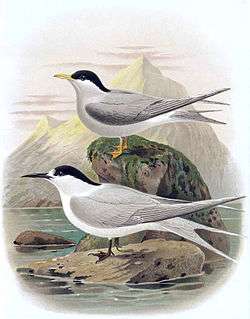Black-fronted tern
| Black-fronted tern | |
|---|---|
 | |
| Scientific classification | |
| Kingdom: | Animalia |
| Phylum: | Chordata |
| Class: | Aves |
| Order: | Charadriiformes |
| Family: | Sternidae |
| Genus: | Chlidonias |
| Species: | C. albostriatus |
| Binomial name | |
| Chlidonias albostriatus (Gray, 1845) | |
| Synonyms | |
|
Sterna albostriata | |
The black-fronted tern (Chlidonias albostriatus) also known as sea martin, ploughboy, inland tern, riverbed tern or tarapiroe,[2] is a small tern generally found in or near bodies of fresh water in New Zealand and forages for freshwater fish, arthropods and worms. It has a predominantly grey plumage. Restricted to breeding in the eastern regions of South Island, it is declining and threatened by introduced mammals and birds.
Taxonomy
The black-fronted tern was first described by George Robert Gray in 1845. Its specific name is derived from the Latin albus "white", and striatus "striped".[3] It is one of four species of marsh tern in the genus Chlidonias, which often live on or near bodies of water inland rather than coastal or at sea. The genus is sometimes sunk into the larger tern genus Sterna, so Sterna albostriata is an alternate scientific name.[4]
The species has several vernacular names; it is called ploughboy or ploughman's friend for its habit of foraging for earthworms and grubs in newly ploughed soil.[5]
Description
Measuring 29 cm (12 in) in length, the adult tern has predominantly grey plumage with a black cap typical of many terns. The underparts and rump are white, and there is a thin white streak running along the cheeks underneath the cap. The bill is red and legs orange. The black cap recedes from the bill in non-breeding plumage and becomes flecked with white.[4]
Distribution and habitat
Within New Zealand, the black-fronted tern is found from the southern tip of the North Island, and along much of the eastern South Island from Marlborough to Southland, and to Stewart Island. There is an outlying population along the Buller and upper Motueka Rivers in southern Nelson. The breeding range is restricted to South Island only. It lives along riverbanks and can forage out to 10 km (6 mi) at sea in the nonbreeding season.[4]
Numbers of black-fronted terns are decreasing across its range, and the species is classified as endangered. Threats include several species introduced to New Zealand - stoats (Mustela spp.), feral cats, the brown rat (Rattus norvegicus), hedgehog, dog, and from Australia, the common brushtail possum (Trichosurus vulpecula), and Australian magpie (Cracticus tibicen).[4]
-
A black-fronted tern nest.
-
Black-fronted tern eggs.
References
- ↑ BirdLife International (2012). "Sterna albostriata". IUCN Red List of Threatened Species. Version 2013.2. International Union for Conservation of Nature. Retrieved 26 November 2013.
- ↑ Rod Morris and Alison Ballance, "Rare Wildlife of New Zealand", Random House, 2008
- ↑ Simpson DP (1979). Cassell's Latin Dictionary (5th ed.). London: Cassell Ltd. ISBN 0-304-52257-0.
- 1 2 3 4 "Species factsheet: Sterna albostriata". BirdLife International. 2009. Retrieved 31 December 2009.
- ↑ "Black-fronted terns". What's the Story? Encyclopedia of New Zealand. Ministry for Culture and Heritage / Te Manatū Taonga. 2009. Retrieved 31 December 2009.
